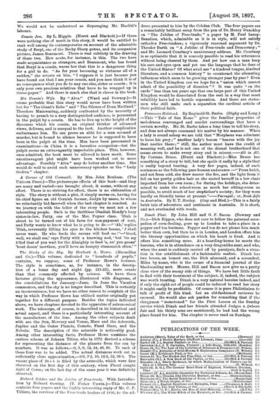The Stv.dy of the Sky. By Herbert A. Howe. (Macmillan
and Co.)—This volume, dedicated to "hundreds of pupils," contains, we suppose, some of Professor Howe's lectures. The style is sometimes, as, for instance, in the descrip- tion of a lunar day and night (pp. 221-22), more ornate than that commonly affected by science. We have three lectures giving the appearance, illustrated with diagrams, of the constellations for January—June. In June the Vacation commences, and the sky is no longer described. This is certainly an inconvenience, but we have no other reason to complain of the way in which Professor Howe has utilised matter originally put together for a different purpose. Besides the topics indicated above, we have chapters devoted to the apparatus of astronomical work. The telescope, of course, is described in its historical and actual aspect, and there is a particularly interesting account of the manufacture of the lens. Among the other subjects dealt with are the Sun, Mercury and Venus, Mars and the Asteroids, Jupiter and the Outer Planets, Comets, Fixed Stars, and the Nebula. The description of the asteroids is noticeably good. Among other interesting facts, Professor Howe mentions the curious scheme of Johann Titius, who in 1772 devised a scheme for representing the distance of the planets from the sun by numbers. It was as follows,-0, 3,6, 12, 24, 48, 96. To each of these four was to be added. The actual distances work out in sufficiently close approximation,-3•9, 7.2, 10, 15.2, 52, 95.4. The vacant place of 24 + 4 is filled by the asteroids, which were first observed on the first day of this century, when Piazzi caught sight of Ceres; on the last day of the same year it was definitely observed.


































 Previous page
Previous page